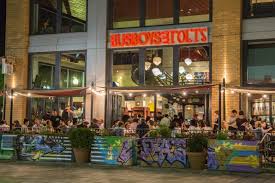Consumers in first-world countries embrace the affordability of clothing mass-produced in the developing world. But they may not stop to think about the conditions that allow for such budget-friendly prices.
A June 5 event at Busboys and Poets on K Street addressed the challenges of convincing or coercing major clothing manufacturers in third-world countries to pay their laborers a livable wage and allow them to campaign for improvements in working conditions.
The presentation at the local cafe focused on a flagship apparel brand, Alta Gracia, a subsidiary of Knights Apparel. The Alta Gracia factory, located in the Dominican Republic, calls itself the only known clothing manufacturer in the developing world to pay its workers a living wage, allow them to unionize and ensure that they are treated with respect while working.
“What’s remarkable at Alta Gracia is that there is a majority of women in decision- making positions in both the leadership of the union and the management of the factory,” said Rachel Taber, a community education coordinator at Alta Gracia. Approximately 80 percent of the Alta Gracia labor force is female, and two of three production logistics managers are women.
Company employees participated in the event via Skype. They spoke about the transformation of their workplace and Taber translated from Spanish to English.
“Alta Gracia is not something that just arrived,” said Maritza Vargas, secretary general of the union at Alta Gracia. “It’s the result of a long process that we as women workers fought to achieve.”
Union Secretary of Finance Yenny Perez added, “Alta Gracia is an example that if you organize and work together you can achieve better conditions.”
Groups advocating improvements for sweatshop laborers hope that Alta Gracia will become a sustainable model for the garment industry, but they acknowledge the difficulties of the concept. George Robertson, a national organizer for United Students Against Sweatshops, said that it is students’ responsibility to put pressure on clothing manufacturers, because “global apparel companies won’t do anything unless you force them to.”
Robertson referenced a landmark 2009 student protest against Russell Athletic, during which more than 100 universities boycotted the company because it shut down a factory that was trying to unionize. After losing an estimated $60 million, Russell reopened the branch.
“That put the rest of the industry on notice that if they were to violate workers’ rights, it would be a big cost,” said Robertson. The case sent the message that “students and workers
wouldn’t tolerate this sort of union busting. It [also] puts to rest a lot of lies that apparel companies like to tell about how it’s impossible to provide good conditions under which workers sell university apparel.”
Once a factory agrees to treat its employees more respectfully, however, labor rights advocates must track and enforce regulations. That’s where the Workers Rights Consortium, which calls itself an “independent labor rights monitoring organization,” came in.
Theresa Haas, WRC Director of Communications, echoed Robertson’s emphasis on student advocacy in the fight for workers’ rights, saying that companies are “only willing to move as far as students and universities force them to.”
“The unfortunate truth is that not much has changed since the 1990s, when codes of labor conduct began,” Haas said. Nevertheless, she expressed hope for broad improvement in apparel production. “Our hope is that Alta Gracia can really be a model that the rest of the industry can follow.”




